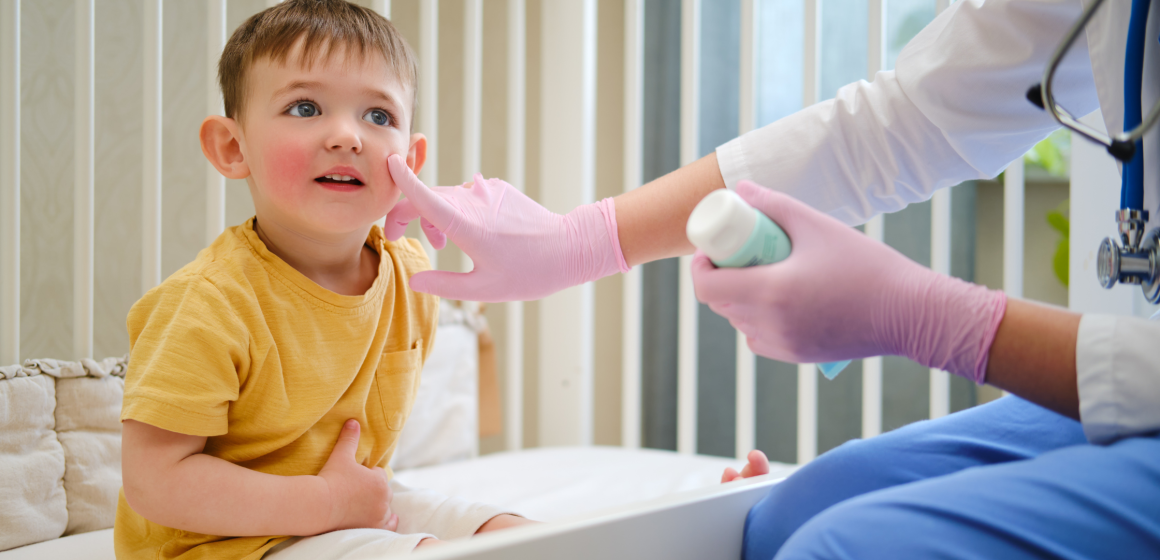Children’s skin is sensitive and can be prone to various conditions that may cause discomfort or concern. From eczema to rashes, understanding the most common childhood skin conditions is crucial for parents to effectively manage and treat these issues. In this blog, we’ll explore some of the most common skin conditions in children, how to recognize them, and the best treatment options available.
Understanding Eczema
Eczema, also known as atopic dermatitis, is a chronic skin condition that causes dry, itchy, and inflamed skin. It’s one of the most common skin issues in children, affecting about 10-20% of infants and young children, according to the American Academy of Dermatology (AAD).
Symptoms of Eczema:
- Dry, scaly patches: Often found on the face, neck, hands, feet, and the insides of elbows and knees.
- Intense itching: This can be severe, leading to scratching that may cause the skin to bleed or become infected.
- Redness and swelling: The affected areas may appear red, swollen, and irritated.
Causes and Triggers:
Eczema is believed to be caused by a combination of genetic and environmental factors. Common triggers include:
- Dry skin
- Irritants (soaps, detergents, fragrances)
Allergens (pollen, pet dander, dust mites)
- Heat and sweat
- Stress
Treatment Options:
While there is no cure for eczema, it can be managed with proper skin care and treatment:
- Moisturize regularly: Use a fragrance-free moisturizer several times a day, especially after bathing.
- Avoid triggers: Identify and avoid factors that may trigger your child’s eczema.
- Medications: Over-the-counter or prescription creams, such as corticosteroids, may be used to reduce inflammation and itching.
- Bathing practices: Use lukewarm water and mild, fragrance-free soap. Pat the skin dry and apply moisturizer immediately after the bath.
Recognizing Rashes
Rashes are another common skin issue in children and can be caused by a variety of factors, from infections to allergies. Here are a few common types of rashes:
Diaper Rash:
Diaper rash occurs when the skin in the diaper area becomes irritated due to prolonged exposure to moisture, friction, or contact with urine and feces.
- Symptoms: Red, inflamed skin in the diaper area; may include bumps or blisters.
- Treatment: Keep the area clean and dry, change diapers frequently, and apply a diaper rash cream containing zinc oxide.
Heat Rash:
Heat rash happens when sweat ducts become blocked, causing small, red bumps on the skin, usually in areas where clothing causes friction.
- Symptoms: Tiny red or pink bumps, often accompanied by itching or a prickly feeling.
- Treatment: Keep the skin cool and dry, dress your child in loose, breathable clothing, and avoid excessive heat and humidity.
Hives:
Hives (urticaria) are raised, itchy welts on the skin that appear suddenly, often due to an allergic reaction.
- Symptoms: Red, raised welts that can appear anywhere on the body; may vary in size and shape.
- Treatment: Antihistamines can help reduce itching and swelling. If hives are accompanied by difficulty breathing or swelling of the face or throat, seek immediate medical attention.
Other Common Childhood Skin Conditions
Impetigo:
Impetigo is a contagious bacterial skin infection that is common in young children.
- Symptoms: Red sores or blisters that rupture, ooze, and form a yellow-brown crust, typically around the nose and mouth.
- Treatment: Topical or oral antibiotics prescribed by a healthcare provider can effectively treat impetigo.
Warts:
Warts are caused by the human papillomavirus (HPV) and appear as small, rough bumps on the skin.
- Symptoms: Hard, rough bumps that may be skin-colored, white, or gray; commonly found on the hands, feet, and knees.
- Treatment: Over-the-counter treatments may help, but persistent warts may require removal by a healthcare provider.
When to See a Doctor
While many childhood skin conditions can be treated at home, certain symptoms may require medical attention. Consult a pediatrician if your child experiences:
- Rashes that are painful, spreading, or not improving with home treatment
- Signs of infection, such as increased redness, warmth, swelling, or pus
- Unexplained or persistent skin changes
- Fever or other systemic symptoms accompanying a skin condition
Trusted Resources for Parents
For more information on childhood skin conditions and their treatment, visit the American Academy of Dermatology (AAD) and the American Academy of Pediatrics (AAP). These organizations offer expert advice and guidelines to help parents manage their child’s skin health effectively.
Conclusion
Understanding and recognizing common childhood skin conditions can help you manage your child’s symptoms and seek appropriate treatment when necessary. From eczema to rashes, knowing what to look for and how to treat these conditions can ensure your child’s comfort and well-being. If you’re ever in doubt, don’t hesitate to consult your pediatrician for guidance and care.












